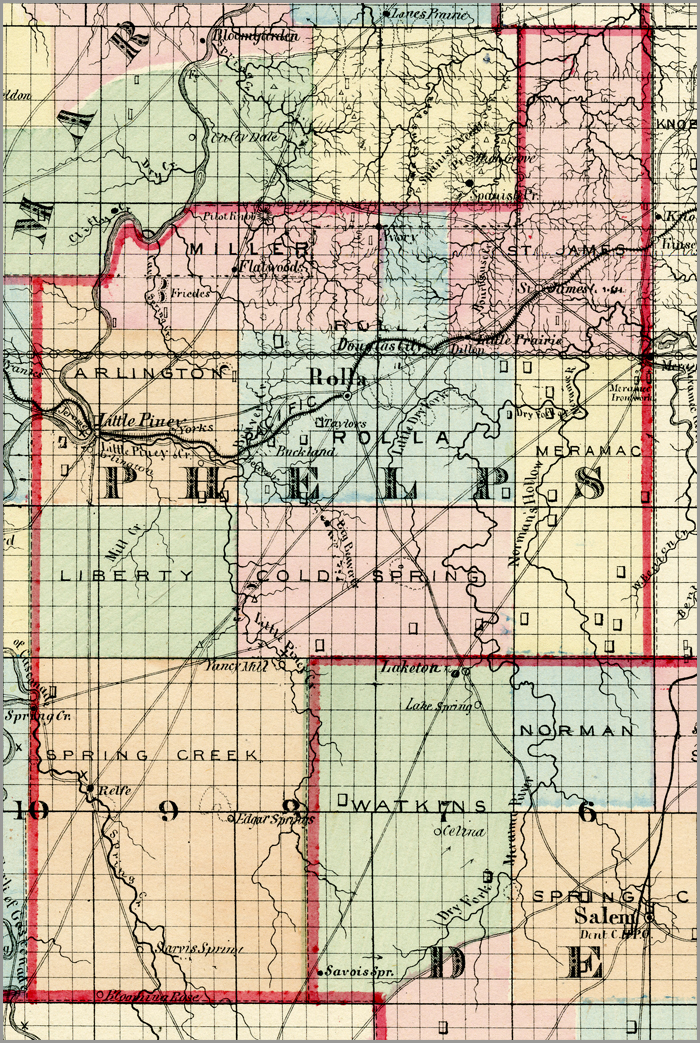Phelps County, Missouri

- Formed: 1857
- County Population 1860: 5,630
- Slave Population 1860: NA
Image courtesy of Wilson’s Creek National Battlefield
Phelps County, Missouri, is located in the Meramec and Gasconade River Basins, including tributaries North Spring Creek, Mill Creek, Camp Creek, and Bourboise Creek. The area has natural limestone, lead, copper, and coal deposits, as well as an abundance of clay for brick-making. There are many different fruit and nut trees native to Phelps County, including plum, pawpaw, mulberry, hackberry, hazelnut, walnut, and butternut. The Phelps County area is sometimes known as the “fruit basket” of Missouri because of the abundance of these trees. The Shawnee tribe traditionally inhabited the area before white settlement.
The first wave of non-Native American settlers arrived 1818-1819. They included James Harrison, whose home served as the first courthouse, Adam Bradford, John York, and Jack and John Duncan. The numerous caves in the area were an additional natural draw for settlers. The caves contained natural saltpeter, the main ingredient in gunpowder. A settler named William Coppedge from Kentucky began to manufacture gunpowder locally drawing from the area’s natural supply of saltpeter. The second wave of settlers arrived in 1825-1826, and included Humphrey Yowell, George Sally, Jack and Moses Brown, David Lenox, and William Arthur.
The Shawnee, even as they were pushed out of their traditional territories, still traded with eastern states. They traded many iron items made from the natural iron ore in the area. On a trip to Ohio, they traded with a store owner named Thomas James, who was interested in where the Shawnee obtained their iron. James accompanied the Shawnee back to the Phelps County area and founded the Meramec Iron Works, a prominent and successful early business, who the town of St. James was named after. Another early business included Henson Coppedge’s whiskey distillery.
Phelps County was officially formed in 1857 out of parts of Crawford, Pulaski, and Maries Counties. It was named after John S. Phelps, a popular congressman from Connecticut and one time resident of Springfield, Missouri. Phelps also later served in the Civil War. The county seat was established at Rolla. A resident named George Coppedge, a native of North Carolina, wanted to name the town Raleigh. The residents eventually settled on the name Rolla. Rolla was an important site during the Civil War, because the southwest branch of the Pacific Railroad ended there. Thousands of Union troops and their supplies came to Rolla by train from St. Louis and then were transferred to wagon trails to go to the battles of Wilson Creek in Springfield, Mo., Pea Ridge, and Prairie Grove in Arkansas, plus a number of other smaller skirmishes. The town of about 600 civilians had a large population of Union troops at that time. Since the Union forces seized control of the town early in the war, they had a big impact upon the town and its operation. Following the Union defeat at Wilson’s Creek on Aug. 10, 1861, the Union Army fell back to Rolla and began building an earthen fort on the top of a hill alongside the present Highway 63 about a mile from the Courthouse. The rectangular fort had a dry moat around the perimeter with 32-pound field pieces located on each corner of the fort to cover any attack on Rolla from the south. It was named Fort Wyman after Colonel John B. Wyman.
Several residents of Phelps County fought in the Revolutionary War and the Mexican War in the late 1840s. When the Southern states seceded before the start of the Civil War, most Phelps County residents sympathized with the South; they were strong believers in states’ rights. However, they felt that the South went too far in seceding, and felt that the Union should be preserved. The Union army maintained control of Phelps County for most of the war. Many of the residents who supported the Confederacy fled southward. There were no major battles in Phelps County, though bushwhackers posed a constant threat of violence and destruction.
Phelps County residents took part in several military regiments. These included: the 32nd Missouri Volunteers under Lieutenant Colonel Warmoth, the 7th Missouri Cavalry under Colonel Bowen, the Rolla Guards under Captain Tiffany, the Phelps County Militia under Major C.P. Walker, and the 9th Missouri Cavalry.
By the end of the war, population estimates show that there were less than 500 people left in the county, most residents having fled north or south depending on their sympathies. Many did not return to Phelps County. New residents began to move to the County when the railroad began construction in 1867. The railroad sped recovery, and Rolla eventually became a booming population center.
 Browse all collections in Phelps County
Browse all collections in Phelps County
- Consulted:
- History of Laclede, Camden, Dallas, Webster, Wright, Texas, Pulaski, Phelps, and Dent Counties (Chicago: Goodspeed Publishing Company, 1971).
- http://www.rollanet.org/areainfo/nwhist.html












